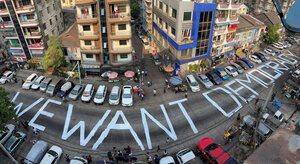Why protest signs in Myanmar are in English
The anti-coup demonstrators are appealing to a more sophisticated global “peace industry” that can track peaceful assembly and shine a light on local conflicts.

A protest slogan is written on a street in Yangon, Myanmar (also known as Burma).
Reuters
If you’ve noticed more images of Myanmar’s protests in the news, there’s a reason for that. The demonstrators are displaying signs in English rather than Burmese to reach a global audience. They make sure to march past foreign embassies. They are also using a well-known gesture, the three-finger salute from “The Hunger Games,” to signify a universal defiance against the military coup of Feb. 1 as well as their own commitment to nonviolence.
Myanmar’s pro-democracy activists know that, unlike during mass protests in 2007 and 1988, the world has far more peace watchers in place, able to track violence against protesters and other innocent people. A global “peace industry,” enhanced by the connective power of the internet, is establishing a norm that peace can be a positive force, not merely the absence of violence. The protesters, says Myanmar expert Richard Horsey at the International Crisis Group, are very much looking for foreign governments to show solidarity with their cause.
The protests have so far drawn one global reaction. On Friday, after the military killed at least 18 protesters, Myanmar’s envoy to the United Nations, Kyaw Moe Tun, broke ranks and addressed the 193-member General Assembly. He asked for strong action by the international community against the country’s generals and a return to democracy.
In another example of the U.N. pushing peace, the Security Council passed a resolution Friday calling for a sustained humanitarian pause in world conflicts to allow for distribution of the COVID-19 vaccine. In Afghanistan, Taliban militants have heeded international concerns and allowed vaccinations to start in areas they control.
The world’s ability to stand guard over peaceful protests has become so sophisticated that there is even an official manual for it. The 57 countries that make up the Organization for Security and Co-operation in Europe just reissued a handbook on how independent observers can monitor peaceful protests. This impartial monitoring “is an effective means of bringing to light violations of the right to freedom of peaceful assembly and other associated human rights, of identifying related challenges and good practices, and of supporting national and international action to guaranteeing human rights and fundamental freedoms,” the OSCE states.
By closely watching protests, international monitors help democratic activists better engage repressive regimes. In Myanmar, says Mr. Horsey, international attention can “support the agency of the Myanmar people at this time.”
In a globalized world, peace is not only local. It has universal appeal.

